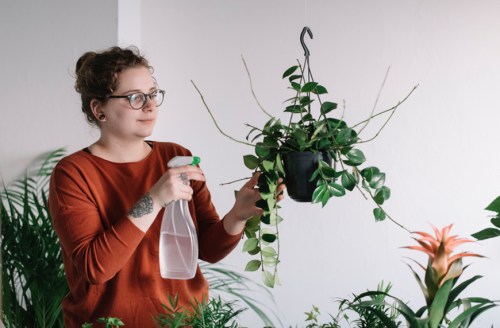The 6 most common mistakes people make with their indoor plants
Indoor plants not looking so hot? These are the most common plant mistakes people make with their indoor jungle, according to experts.

Caring for plants is both incredibly rewarding and downright stressful. When your plants are thriving, all is good in the world. But when one starts to look unhappy, you instantly look to Dr. Google for some help in order to save your indoor plants from the brink of death.
While there are many reasons why your indoor plants can suddenly start to lose their luster, there are a handful of common plant mistakes experts see people make all the time. And there’s a good chance we’ve all made at least a couple of them. Whether you’re hoping to avoid any problems in the future or are trying to figure out where the heck you went wrong, here’s exactly what you should know about keeping your plants in tip-top shape.
The 6 most common plant mistakes to avoid
1. You’re not pruning your plants
It’s not just outdoor gardeners who should be pruning their plants—it’s also those who have house plants indoors. According to Susan Spanger, professional gardener and floral designer of Bloomful Floral Design, it’s something many people are afraid of because they’re not sure how to approach it. Surprisingly, it’s a lot easier than you’d expect. “Think about how you need to trim the dead ends of your hair to stimulate new growth,” she says. “To extend a plant’s blooming period and encourage healthier, larger blooms, you must cut off dead and dying blooms by snipping at the base of the flower’s head.”
To start, Spanger says you need a sturdy, sharp pair of clean scissors, or a garden pruning tool such as clippers. “Closely examine plants and remove any diseased, discolored, or leggy leaves and stems,” she says. “For popular trailing pants, such as pothos and English ivy, rejuvenation comes with cutting them back to four to six inches tall. Succulents are very self-sufficient, but it’s still helpful to remove the dead shriveled up leaves at the base of the plant.”
2. You’re being overattentive
As a plant mom, it’s hard not to care too much for your plants. Unfortunately, it’s one of the most common plant mistakes keeping them from looking as healthy as the day you brought them home. “It might sound silly, but less is more when it comes to care for most houseplants. Plants are hardier than we think and they can tolerate a bit of neglect. They might even appreciate it,” says Erin Marino, plant expert and director of marketing at The Sill. “Specifically during the long winter months when most indoor tropical plants are dormant, you’ll want to water them less, and set your expectations for your plants losing a few leaves. It’s a natural, seasonal shedding process that happens when plants don’t get enough sunlight to support their current leaves.”
3. You’re using fertilizers
You’d think buying fertilizers would do your plants good, but Spanger says they typically don’t need it. “I usually advise against buying fertilizer unless a houseplant is really struggling to grow,” she says. If they’re already doing well, you can give them a boost with some DIY compost. “It’s easy to make your own homemade compost comprised of kitchen scraps, garden trimmings, and manure if you can get your hands on some. All indoor and outdoor plants love compost.”
4. You’re not using self-watering methods.
Spanger sees many frustrated customers who left their beloved houseplants with friends while they’re away from home, only to return to a sad-looking plant. That’s why she always suggests using a self-watering method instead to avoid one of the common plant mistakes. “For a long weekend away, take an empty wine bottle with an aluminum cap and use a hammer and nail to create five mini holes. Rinse it out well, fill it entirely with room temperature water, and place it bottle cap-side first in a small hole that you dig in the soil,” she says. “Or, for a faster solution, garden centers should carry a variety of self-watering systems and practical tools that are user-friendly.”
5. You’re not repotting your plants
Repotting your plants can be scary, but now’s the time to face your fears and go for it. “Early spring, before the growing season, is the best time to repot your plants. And repotting doesn’t always mean moving your plant into a bigger planter—sometimes it simply means changing your plant’s potting mix to provide it with new nutrients from fresh mix,” Marino says. “However, if your plant has overgrown its current planter, choose a new pot that’s only slightly larger in size. Upsizing should be a gradual process through the years. You don’t want your plant ‘swimming’ in potting mix, which can lend itself to overwatering and potentially root rot.”
6. You’re letting your plants get all dusty
Take a second to wipe one of your plant’s leaves with your finger. If your finger is dusty, you could be hurting your plant without realizing it. “Keep an eye out for dust that has built up on leaves and routinely wipe them clean with a damp cloth or soft brush if the plants have hairy leaves,” says Spanger. “Too much dust can clog a plant’s pores, making it harder for the plant to breathe.”









